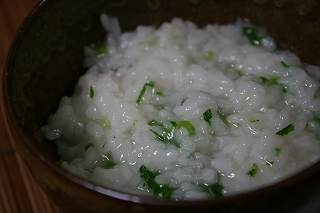NANAKUSA-GAYU
During SYOGATU holidays, many Japanese people tend to eat and drink too much,
they often have some problems of their stomach.
Seventh January is the day when we eat NANAKUSA-GAYU, rice porridge with
seven medical plants to take care of our body,
which is our custom for a long time.

Japanese are very likely to have KAYU, simple rice porridge,
when they feel sick in the first place,
because KAYU is easy to digest even with a tired stomach.
As far as NANAKUSA-GAYU, medical plants help to care for our body in addition.
NANAKUSA means seven medical plants in Japanese.
Traditional NANAKUSA, seven plants, are SERI, NAZUNA, GOGYOU, HAKOBERA,
HOTOKENOZA, SUZUNA and SUZUSHIRO, however most of them are not
to our modern taste at all.
For example, NAZUNA is just a weed seen on roadsides
instead of at supermarkets, which I don't feel like eating.
GOGYOU, HAKOBE and HOTOKENOZA as well.
On the other hand SUZUNA or SUZUSHIRO is green part of Japanese radish.
They are still easy to get at supermarkets and taste good even for us.
Now some have NANAKUSA-GAYU with one or two medical plants,
and some have one with different seven vegetables instead of traditional ones.
Even though the style of NANAKUSA-GAYU is changing,
the custom itself seems to be continued
as far as Japanese celebrate New Year's Day!
As far as I'm concerned, my mother cooked KAYU with SUZUNA and SUZUSHIRO for us!




